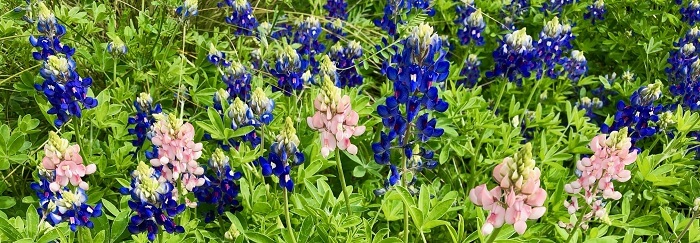Bluebonnets Selected Texas State Flower
Did you know that at one time the cactus flower was considered as a prospect for the Texas State Flower? Another option was the cotton boll. Did you know there are 5 varieties of Bluebonnets in Texas? Did you know there was a Bluebonnet war?
Well this is all true!!! The story kind of goes like this. The Texas Legislature was intent on selecting a flower to represent Texas as its emblem. John Nance Garner from Uvalde, Texas proposed the cactus bloom because the cactus is so hardy and its bloom so lovely.
Since cotton was king back in 1901, one legislator was really fired up about the cotton boll.
The National Society of Colonial Dames of America were smart in presenting their choice. They brought Mode Walker’s 1900 bluebonnet painting to the Texas State Legislature to ask that it become the Texas state flower. Sure enough, the 27th Texas Legislature did adopt the bluebonnet Lupinus subcarnosus as the state flower on March 7th, 1901.
The Bluebonnet War
One would think that the story of the Texas bluebonnet ends there but such is not the case! This choice actually started the Bluebonnet War because others wanted the more showy Hill Country variety of bluebonnet, Lupinus texensis, to be the Texas State Flower. Finally, after the war waged on for 70 years, the Legislature resolved in 1971, that “the Lupinus texensis and any other variety of bluebonnet not heretofore recorded be recognized along with the Lupinus subcarnosis as the official state flower of the State of Texas.”
Other varieties of Texas bluebonnets are the really tall Lupinus Havardii or Big Bend bluebonnet from West Texas. On the other end of the size spectrum is the tiny Lupinus concinnus. Lupinus plattensis is the only perennial variety of the Texas bluebonnet. Lupinus Subcarnosus grows in sandy soil and does not do well in clay or other soil types.
By the way, if you care to go see the painting that started it all, go visit the Neill-Cochran House Museum in Austin Texas. You will see Mode Walker’s painting Bluebonnets and Evening Primrose, c.1900 hanging there.
The Second Bluebonnet War

In April 2014, Texas A&M-colored maroon bluebonnets started blooming mysteriously around the UT Tower. Suspiciously, the offending flowers were only found near the tower and nowhere else on campus. While Longhorns suspect that Aggies must have somehow spread the special seeds, no one knows for sure what happened.
In 1982, Dr. Jerry M. Parsons, a horticulture specialist with the Texas Cooperative Extension in San Antonio, was given the job of recreating the Texas State Flag with bluebonnets. Since red bluebonnets do not exist, Dr. Parsons decided to create a red bluebonnet. He focused his efforts on breeding variations of the naturally-occurring pink bluebonnet. It’s still the Lupinus texensis but it now has a maroon variety. If planted alongside natural bluebonnets, they’ll cross-pollinate and the next generation quickly loses their red color.

